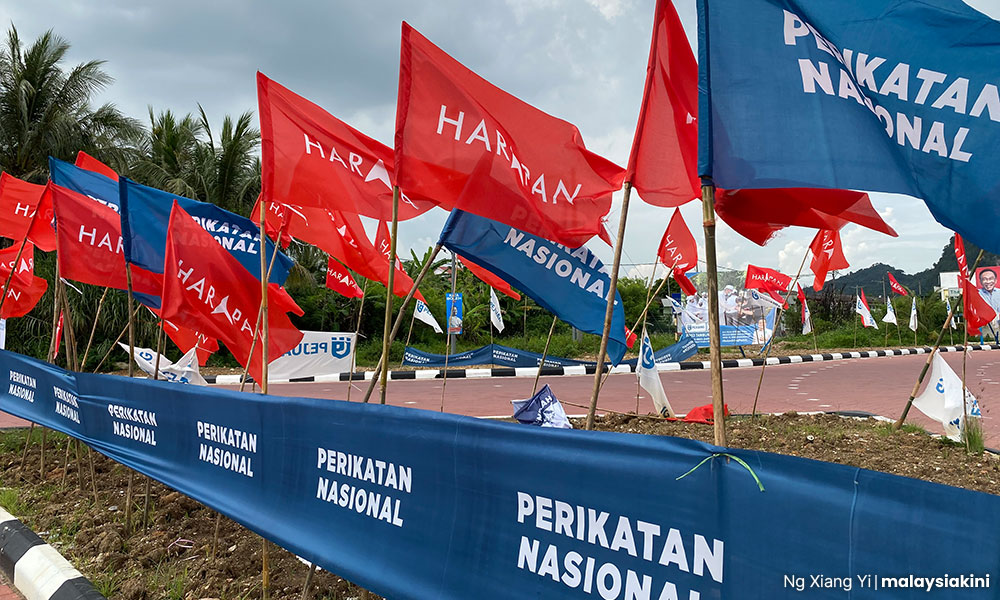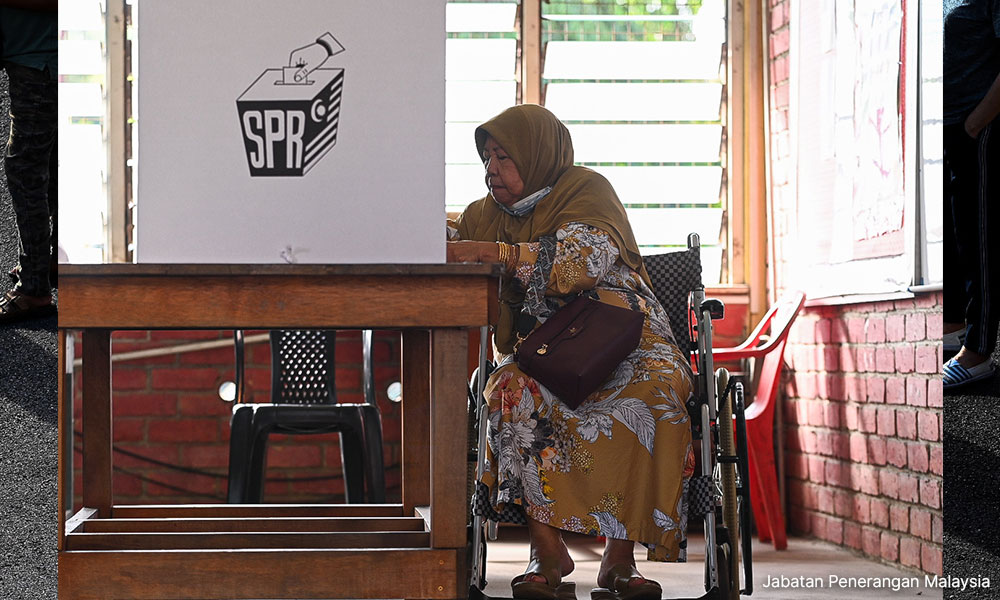Voting in Malaysia’s 15th general election (GE15) was one of the most ethnically polarised in history, while simultaneously reflecting significant electoral swings across almost all of the country’s ethnic communities.
This seven-part series looks at ethnic voting patterns - turnout and coalition support - in last year’s November polls.
The findings, which will be discussed in more detail over the next week, show a dynamic and changing electorate, one no longer beholden to traditional loyalties to political parties to the same degree as in the past.
The changes are not just among the young (generation voting is for another series); with greater democracy, the Covid crisis, and political instability, transformative shifts are taking place in electoral politics “from below” even as there are new elite alliances and different options for voters to choose from.
Major national findings
In the first of this series, this introductory piece, I highlight the broad national findings on ethnic voting trends, explain the methodology used, and, importantly, the limits of the methodology.
Let me stress from the outset that the election results from four months ago do not reflect current political support, especially given the different configurations of government, political alliances and developments in national politics, even in the last week.
Please note that this is a more comprehensive study than the preliminary analysis published last November.
This “almost complete” analytical series is based on the findings at the polling station level – a total of over 7,700 points, covering (almost) every corner and village of Malaysia (except the 10 seats* where score sheets have yet to be released by the Election Commission due to ongoing legal challenges).
A total of 95 percent of the polling stations in the country are analysed, including Borneo.
Here are the main takeaways:
Ethnic variation turnout: Despite a broadening participatory process in elections, there remains a large number of potential voters who do not vote and this also falls and varies along ethnic (and regional) lines.

Multiple ethnic swings: Ethnic swings in voting are not confined to one community, but occurred across various communities, including those in Sabah and Sarawak. Part of this is a product of the electoral polarisation that occurred across communities.
Yet, the findings over time show multiple swings evident among different groups of voters, a reflection of the calls of different communities for better governance and representation as well as how they are being mobilised by political parties.
Ethnicity matters more in voting: Ethnicity as an explanation of voting has become more salient than in recent earlier elections (GE14 2018 and GE13 2013), reflecting the intense ethnic mobilisation of the electorate in GE15.
Identity politics is the default mobilisation of parties that cannot deliver better policies and governance. It is also the product of older leaders who are not willing to let go of narratives of the past. GE15’s heightened racialised campaign engendered a more divided electorate.
This contemporary greater electoral salience of ethnicity arguably has its roots in the Mahathir era, intensified during the Najib era to shore up his support after the 1MDB scandal and subsequently deepened when Umno/BN lost power in 2018 after Pakatan Harapan won GE14.
Despite Malaysia being a more cosmopolitan, diverse society, its politics remain caught in entrenched ethnic frameworks, fuelled by leaders who refuse to embrace alternative narratives.
Ethnic polarised electorate: The ethnic political polarisation of Malaysia’s electorate was highly (and worryingly) significant in GE15, with one of the major coalitions, Perikatan Nasional, not winning support outside of one community, and the other coalitions – Pakatan Harapan and Umno/BN with uneven electoral support across different communities.

Malaysia’s voting in GE15 was one of the most ethnically divided in history, especially in Peninsular Malaysia.
With Umno’s electoral collapse and the prominent use of racialised ethnic appeals in the campaign across coalitions, the multi-ethnic “middle ground” has narrowed significantly. Ironically, Umno’s greater reliance on mobilising ethnic support from the Najib era and the resulting deepening political polarisation post-2015 served to undercut their political fortunes.
Regional variation in ethnic support: The findings show that there are important and major regional variations in patterns of ethnic political support, a point made by fellow researcher Ong Kian Ming. These are tied to the varied strengths of the party machinery, control of state governments, and local dynamics.
There are also considerable differences among individual seats within different states. While the “candidate” factor was not as important in bucking broader ethnic voting trends, it is not insignificant in helping us understand the significant variance across states and seats.
Borneo's own patterns: Sabah and Sarawak have their own unique and dynamic ethnic voting patterns. This series treats them with the special attention they deserve.
It is a mistake to underestimate and equate the changing political currents taking place across every part of Malaysia. Those who (mistakenly) claim to speak for “all Malays” must begin from a premise that ethnic identity varies within communities and in different contexts of Malaysia, especially in Borneo.

A look at the methodology
Ethnic voting is only one lens to understand voting behaviour in Malaysia. Other socio-economic lenses that are important include generation (age cohorts), gender, level of urbanisation, regionalism and class.
Studies have also looked at economic voting (perceptions of the economy) and the role of religion and religiosity in voting as well. I have long argued (and promoted) different lenses to understand Malaysia’s complex and changing society.
This study/series presents only one lens, ethnic voting. Others will follow (when they are completed as analysing data is a time-consuming process.)
This research uses a statistical method called ecological inference which estimates individual behaviour from micro-grouped units.
The units aggregated are polling station election results – available on official scoresheets from the Election Commission – and the GE15 electoral roll groupings of ethnicity, age and gender at the polling station (and saluran - queue line - levels) also available from the Election Commission.
No personal individual data is used, as estimates are made from aggregating and comparing different groupings of data. With thousands of different units to compare, an inference or estimate of group behaviour is made. The main/largest ethnic categories of the different communities - Indian, Chinese, Malay and Others - are used for the framing of ethnic voting.
The earlier preliminary analysis focused on Peninsular Malaysia only and used macro data. This study is more robust, as it uses more data points. As such, this analysis allows for an understanding of regional variation. There is attention to both voter turnout and support for different political coalitions in different states.

Having pioneered the application of this method to understand Malaysian voting at the polling stations and saluran levels for over a decade, ecological inference has been found to both explain and predict electoral outcomes. This is particularly the case for Malaysia as ethnicity is closely tied to voting behaviour.
There are, however, limits to this methodology. Ecological inference may help identify patterns, but it does not explain the underlying reasons why they occur.
Why, for example, did Malays abandon Umno? Here, other methods – interviews, focus groups, surveys, and analyses of social media – are needed.
My interpretation of the numbers in the series draws from hundreds of interviews with voters and with focus groups, conducted before and after GE15.
Other studies and methods are a needed complement (and welcomed) to better understand voting.
Importantly, the findings on election support refer only to those who voted. While we can estimate how many did not vote, we do not know who they would have supported. GE15 has a turnout of 74 percent, as over a quarter of voters did not vote.
Ecological inference is also limited in that it is an estimate of individual behaviour based on multiple group measures, so it should only be interpreted as an indication of trends, rather than as an exact number.
I cannot stress enough that these findings should not be over-interpreted to speak about a community as a whole; there is no one pattern of support for one community, there are many patterns.
Reading ahead
Many readers will not be happy with the results. They should not be. The findings confirm that Malaysia is a deeply divided country electorally. They reinforce my earlier call that more needs to be done to address these differences, to move politics away from race.
Political polarisation remains a deeply worrying reality of the nation’s politics. If these concerning trends continue, the political instability at the elite level risks evolving into a force driven “from below”.
At the same time, the findings also show how dynamic politics in Malaysia is “from below”. Changes are ever possible, but not all of these changes are necessarily constructive for a stronger nation.
Parties and leaders should take away the reality that they need to perform, deliver and engage in new ways as voters expect more and opt to elect different leaders/coalitions.
The ethnic voting swings show that all communities cannot be taken for granted.
*The following score sheets in these seats were not used in the analysis as they are not yet available: Kemaman, Kuala Terengganu, Lubuk Antu, Marang, Masjid Tanah, Putatan, Sandakan, Segamat, Tenom and Tuaran. - Mkini
BRIDGET WELSH is an honorary research associate of the University of Nottingham, Malaysia’s Asia Research Institute (Unari). She is also a senior research associate at the Hu Fu Centre for East Asia Democratic Studies and a senior associate fellow of The Habibie Centre. Her writings can be found at bridgetwelsh.com.
The views expressed here are those of the author/contributor and do not necessarily represent the views of MMKtT.




No comments:
Post a Comment
Note: Only a member of this blog may post a comment.